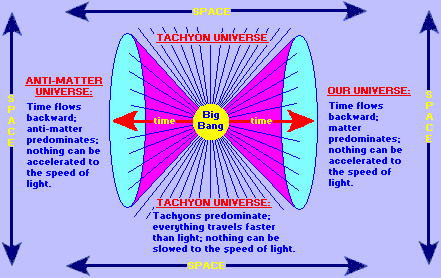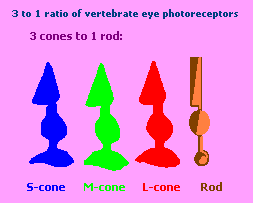(The Study of Threes)
http://threesology.org
3 Universe Cosmology of J.R. Gott III:

Note: The above illustration is a re-creation of the picture on page 125 from the book "Breaking The Mind Barrier" by Todd Siler, 1990.
***J.R Gott III estimates that our best current time traveler is Russian cosmonaut Sergei Avdeyev who was in orbit for a total of 748 days during three space flights. Avdeyev's prolonged travel made him a younger man (by about one-50th of a second) than those of us who have remained on Earth.
3 ideas which have greatly influenced our modern views about the creation of the Universe:
- Einstein's Theory of Relativity.
- Hubble's expanding Universe.
- Nrno Penzias' & Robert Wilson's microwave detection.
3 phenomena of Big Bang theorists: Helium abundance ~ Microwave background ~ Hubble expansion
3 general (Hubble) classes of galaxies, based on the optical appearance of galaxy images on photographic plates: Ellipticals ~ Spirals ~ Irregulars (Spirals are subdivided into normal & barred, each with an additional 3 sub-types.)
3 second burn of a 100 watt electric light bulb is the duration that would occur of all of the antiprotons presently produced at CERN in one year. (It is said that it will take tons of anti-protons to travel to interstellar destinations.)
3 Big Bangs:
- The "original" Big Bang of the Universe.
- Mammoth explosion of a nearby massive star.
- 65 million year old "Dinosaur killer" rock that caused a nuclear winter
With respect to a 1~ 2~ 3 maturational development sequence occurring on a biological level, we should consider the possibility that our present 3-dimensional system arrived through the process of a 1-dimensional~ 2-dimensional~ 3-dimensional pathway that also proceeds into a 3-to-1 ratio event.
Triple alpha process occurring in the interior of stars at 100 million degrees is responsible for the nuclear formation of carbon.
3 classical Origin-of-Moon hypothesis:
- Binary planet or "sister" hypothesis.
- Rotational fission or "daughter" hypothesis.
- Capture or "wife" hypothesis.
3 to 1 ratio:
- 1 of 3. Fission- Originally part of Earth but torn free.
- Problem: would have fallen back or been flung into space, not into orbit.
- Should orbit in Earth's equatorial plane.
- Fails to explain why lunar chemistry differs from Earth's.
- 2 of 3. Co-Creation- Formed in its present orbit.
- Should orbit in Earth's equatorial plane.
- Fails to explain why lunar chemistry differs from Earth's.
- 3 of 3. Capture Formed as a separate planet but captured by Earth.
- Explains why Moon orbits in same plane as other planets.
- Conditions for successful capture very stringent.
- 1 of 1. Impact- Formed from Mega-Impact of Mars-sized planet.
- Computer modeling suggests solar system forms 100 or so small planets which then collide to make larger objects.
- Explains why Moon orbits in same plane as other planets.
- Can explain why lunar chemistry differs from Earth's.
- Avoids fatal problems of other theories.
- Currently favored model.
http://www.uwgb.edu/dutchs/planets/moon.htm
3 major (Moon) rock types: Potassium-rich basalt ~ Anorthosite ~ An Iron, Titanium-rich basalt
3.3 g/cc (low) density of the moon shows that it does not have a substantial iron core like the Earth does.
http://starchild.gsfc.nasa.gov/docs/StarChild/questions/question38.html

3 basic forms of Matter: Solids -Liquids -Gases
3 to 1 ratio of basic forms of matter: [Solid - Liquid - Gas] ---------{Plasma}
3 atoms to (triangular-shaped) water molecules: Hydrogen - Hydrogen - Oxygen
3 phase model of ISM (Inter-Stellar Medium) proposed by C.F. McKee and J.P. Ostriker in 1977:
... In their model, supernovae produce the 'hot ionized medium' (HIM), the ~ 106 K component of the ISM in their bubble interiors, as well as enhancing the formation of the 'cold neutral' (CNM), 'warm neutral' (WNM) and 'warm ionized' (WIM) media along the compressed edges of remnants.
Source:
http://nedwww.ipac.caltech.edu/level5/Hawthorn/Haw5_2.html
The interstellar medium (ISM) is a term used in astronomy to describe the rarefied gas that exists between the stars (or their immediate "circumstellar" environment) within a galaxy. The interstellar medium is usually divided into three phases, depending on the temperature of the gas: hot (millions of kelvin), warm (thousands of kelvin), and cold (tens of kelvin).
Source: --- Instellar Medium ---
http://www.brainyencyclopedia.com/encyclopedia/i/in/interstellar_medium.html
Additional source: Page 268, Extreme Ultraviolet Astronomy, Edited by Roger F. Malina and Stuart Bowyer, ©1991 Pargamon Press, Inc. ISBN 008037302X (Hardcover)
- 3 basic Rock forms: Igneous ~ Metamorphic ~ Sedimentary
- 3 forms of Carbon: Diamonds ~ Graphite ~ Fullerene
- 3 forms of Atomic radiation: Alpha - Beta - Gamma
- 3 basic materials used in magnets: Iron ~ Cobalt ~ Nickel
- 3 millimeters thick is considered a typical magnet by some standards.
- 3 magnetic materials: Hard ~ Soft ~ Semi-hard (recording materials).
- 3 oxygen compounds of iron: Ferrous Oxide FeO ~ Ferric Oxide Fe2O3 ~ Ferroferric Oxide Fe3O4
- 3 true Allotropes of iron: Delta Iron ~ Gamma Iron ~ Paramagnetic Alpha Iron (formerly called Beta Iron)
- 3 major wavelengths of sunlight: Visible ~ Ultraviolet ~ Infrared
- 3 ultraviolet radiation divisions: Near (4,000 - 3,000 Å) ~ Middle (3,000 - 2,000 Å) ~ Long (2,000 - 100 Å)
Kelvin; K (after Lord Kelvin, 1824-1907): The fundamental SI unit of thermodynamic temperature defined as 1/273.16 of the thermodynamic temperature of the triple point of water.
Triplets are the most commonly found phosphorescing states.
3 elementary particles
(those that are neither created nor destroyed):
- Right Hand branes.
- Left Hand branes.
- N-particle.
3 to 1 ratio of N-particle collection:
- 1 of 3- Electric fields
- 2 of 3- Magnetic fields
- 3 of 3- Gravity fields
- 1 of 1- and photons are collections of N-particles.
3 patterned division of David Martin Degner's five fundamental forces:
- Recoil.
- qE and qcB.
- qv x B and qv x E/c.
3 X 3 (9)-patterned reference of 3 items explaining the T.O.E: Theory Of Everything in nine words:
3-part solution to the energy problem:
[Catch photons from the sun and store them in chemical covalent...]
by David Martin Degner
http://www.daviddegner.com/
In understanding an idea about patterns-of-three, it must be acknowledged that while in many instances the 1 ~ 2~ 3 sequence is clearly identifiable, this is not the case in all representative examples. Some of the examples that will be cited, such as in physics, do not exhibit earlier developmental characteristics but are nonetheless inferred.
For example, we of today say that Quarks occur in groups of twos and threes, and it is inferred that there must have been a time when singular Quarks existed billions of years ago. Such an inference is due to the common sense notion that a circumstance of singularity precedes a circumstance of duality which, in turn, precedes a circumstance of Triplicity. In other words, before there is a "3," there must be a "2," and that before the "2" there was a "1," though the "1" had occurred so far in the distant past, there are no known examples, or known examples are not as yet identified as being part of an overall 1- 2- 3 sequence.
This 1 ~ 2 ~ 3 sequence formula, in many examples, may exhibit characteristics that suggest there was, is, or will be a degree of overlapping, though the overlapping did, does, or will take place in a manner and length of time that is not easily discernible in conventional terms of measurement with respect to a human life time.
Some examples will not exhibit a distinctly identifiable 1 ~ 2 ~ 3 expression, but may nonetheless show one or more of the following:
An overall pattern-of-three reference with or without 3 individual items being displayed- (Words such as trinity, triad, Triplicity, ternary, triplet, etc., are labels that reference a pattern-of-three but do not in and of themselves exhibit three individual items.)
A reference to a "3" but there is no "1" or "2" characteristic that is commonly associated with the "3"- (Such as the Earth being the 3rd planet from the Sun. We do not customarily refer to the Earth as being part of a triadic structure.)
A reference to the "3" as much, many, several etc.,
This also includes expressions which attempt to project an image of being greater than 3, but are in and of themselves merely elaborate extensions of the 3 such as in the case of having 3 common sizes: small- medium- large, and then extending the 3rd size with 3 additional references of X large- XX large- XXX large, which, in this case is an identifiable example of a 1-[X] ~ 2-[XX] ~ 3-[XXX] pattern. Other examples attempt to express a quantity larger than "3" by giving a numerical reference such as four, yet many so-called 4-patterned references can be identified as 3 to 1 ratios.
For examples of the 3 to 1 ratio, you can begin here:
*** Mendelian inheritance is usually described as
the process by which one of two alternate alleles of a gene is inherited
from each parent so that the offspring has one of the following
combinations: two dominant alleles, two recessive alleles, or one of
each. If both parents are heterozygous, that is, have one of each
allele, the three genotypes will occur among the offspring with the
following probabilities: one homozygous dominant, two heterozygotes, and
one homozygous recessive. Phenotypically the two heterozygotes will
be indistinguishable from the homozygous dominant.
This results in the famous 3:1 ratio.
(James C. King, The Biology of Race, 1981, page 28)

---Mendel's Genetics ---
http://anthro.palomar.edu/mendel/mendel_1.htm
Here is another example of a 3 to 1 ratio:

--- Photoreceptors ---
http://webvision.med.utah.edu/photo2.html
For those who look at the above rods and cones from the perspective of basic geometric configurations, with the cones as triangles and the rod as a linear form, I have put together a few examples of other linear - circular - triangular ideas on the following page:
http://www.threesology.org/intro-page-3c.php
3 to 1 ratio of the so-called four horsemen in the book of Revelation:
1 of 3. A man on a white horse, with a bow and a crown, who is a conqueror-- a true "man on horseback"-- this may be the Antichrist. (The planet Jupiter is said to symbolize this horsemen-- in Revelation 13, the Antichrist brings "fire down from heaven"...Jupiter or Thor with their thunderbolts.)
2 of 3. A red horse, whose rider has a sword -- war. (The planet Mars is thought to symbolize this reference, due to the ancient ideas surrounding the "red planet" and its connotations with war.)
3 of 3. A black horse, whose rider is holding a pair of scales in his hand, symbolizing famine and economic depression. (This horseman is referenced with the planet Saturn, associated in Greek/Roman/Etruscan mythology with agriculture as well as weights and measures and coins.)
1 of 1. A pale horse, whose rider is named Death, and Hades rides with him. Referenced with the planet Pluto-- Lord of the Underworld, Land of the Dead.
by T. Chase
http://www.revelation13.net/horsemen.html
With respect to the "3," a 3 to 1 ratio reference may be seen as a simplified expression of a more elaborate appreciation of a 3-part "ratio" sequencing:
- 3 to 1: one
- 3 to 2: two
- 3 to 3: three
...Each of which (and all of which) can be viewed as enumerated references to varying three-patterned formulas that may be added, subtracted, divided, "or" multiplied, etc...
3 more examples of the 3 to 1 ratio are illustrated in the following trinitarian (religion-related) ideas:
Basically, the universe consists of three elements: Time, Space, and Matter. Each of these is comprised of three 'components'.
| Time = | Space = | Matter = |
| Past | Height | Solid |
| Present | Width | Liquid |
| Future | Depth | Gas |
 | ||
As the Trinitarian doctrine maintains, each of the persons of the Godhead is distinct, yet they are all each, by nature, God. (A 3 to 1 ratio.)
With time, for example, the past is distinct from the present, which is distinct from the future. Each is simultaneous. Yet, they are not three 'times', but one. That is, they all share the same nature: Time.
With space, height is distinct from width, which is distinct from depth, which is distinct from height. Yet, they are not three 'spaces', but one. That is, they all share the same nature: Space.
With matter, solid is not the same as liquid, which is not the same as gas, which is not the same as solid. Yet, they are not three 'matters', but one. That is, they all share the same nature: Matter.
Note that there are three sets of threes. In other words, there is a trinity of Trinities. If we were to look at the universe and notice these qualities within it, is it fair to say that these are the fingerprints of God upon His creation? Not only is this simply an observation, but it is also a good source for an analogy of the Trinity.
by the Christian Apologetics & Research Ministry
http://www.carm.org/doctrine/trinitylook.htm
Yet, do the various patterns-of-three illustrated here and elsewhere with triangular configurations, represent the (three?) fingerprints of God, or variations of some type of unrecognized mark of a branding iron ritual "roundup"? Are humans actually able to simply be finger-painted upon by God and respond in a corresponding manner, or must humans be herded along like dull-witted cattle that must be branded on atomic, molecular, and genetic levels?
Three things reflected in the helium abundance:
- The proton/neutron ratio at the time that nucleo-synthesis starts.
- The ratio of photons to baryons.
- The actual baryon density.
Three First Minutes Observations:
- The Universe is Expanding.
- Currently there is a photon background that peaks in the Microwave part of the spectrum. & This indicates the current temperature of the Universe is 3K.
- The ratio of photons to baryons now is 1 billion to one.
Three big unknowns:
- What is the physics of the very early Universe when all the forces were unified?
- What physics determined the masses of the particles? That is, why does a proton weigh what it does?
- What physics determined the matter -vs- anti-matter asymmetry. That is, why for every 1 billion anti-protons there was 1 billion and 1 protons.
http://zebu.uoregon.edu/2002/ph123/lec06.html
Three major categories of galaxies:
Spiral galaxies look like flat white disks with bulges in their centers and beautiful spiral arms. Spiral galaxies usually consist of three components: a flat large disk, an ellipsoidally formed bulge and a halo.
Elliptical galaxies are redder, more rounded, and often longer in one direction than in the other, like a football. Elliptical galaxies are ellipsoidal agglomerations of stars, which usually do not contain much interstellar matter and look smoothly like small wads in the telescope. Photometric studies of elliptical galaxies strongly suggest that they are triaxial (all the three axes of the ellipsoid are of different sizes).
Galaxies that appear neither disk-like nor rounded are classified as irregular galaxies. A small percentage of the large galaxies we see nearby fall into neither of the two major categories. This irregular class of galaxies is a miscellaneous class, comprising small galaxies with no identifiable form like the Magellanic clouds (the --- Large Magellanic Cloud --- (http://www.seds.org/messier/xtra/ngc/lmc.html) and --- Small Magellanic Cloud --- (http://www.seds.org/messier/xtra/ngc/smc.html) are two satellite galaxies of the Milky Way) and "peculiar" galaxies that appear to be in disarray like --- NGC 1313 --- (http://www.ast.cam.ac.uk/AAO/images/image/aat064.jpg).
http://curious.astro.cornell.edu/galaxies.php
3 percentage division of the "Concordance" model of the Universe:
- Over 70% is made up of dark energy.
- About 25% is composed of dark matter.
- 5% is normal matter.
Herb O. Buckland
herbobuckland@hotmail.com